Planning for Growth
VerifiedAdded on 2023/01/13
|11
|3604
|29
AI Summary
This report analyzes key considerations for organizations to evaluate growth opportunities and potential sources of funding for businesses. It discusses factors such as competitive advantage, Porter's generic strategies, and PESTEL analysis. It also explores the Ansoff's growth vector matrix and different funding options like bank loans, crowdfunding, peer to peer lending, and angel and venture finance. The report provides insights into the benefits and drawbacks of each funding option and recommends crowdfunding as the best option for Bonmarché.
Contribute Materials
Your contribution can guide someone’s learning journey. Share your
documents today.
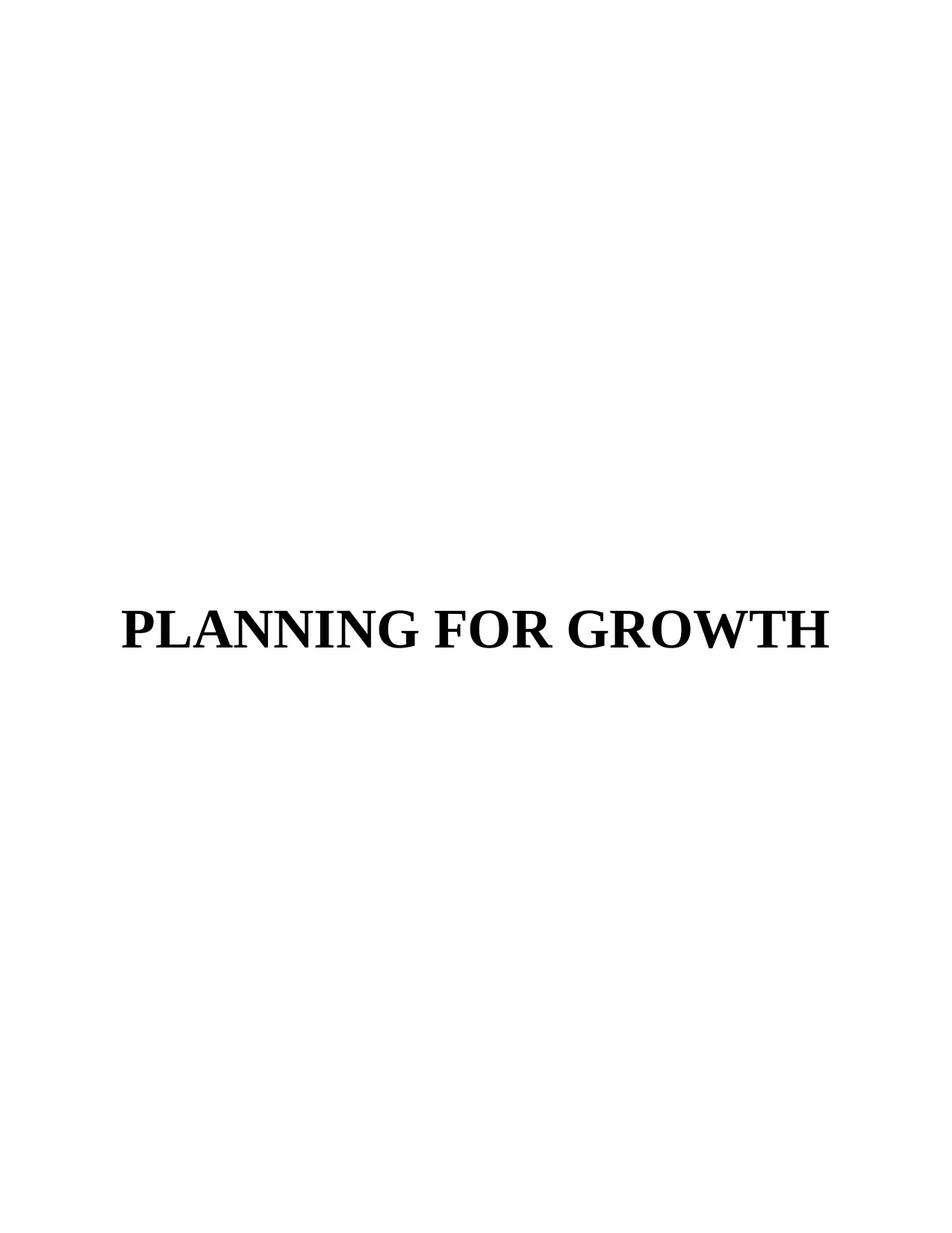
PLANNING FOR GROWTH
Secure Best Marks with AI Grader
Need help grading? Try our AI Grader for instant feedback on your assignments.
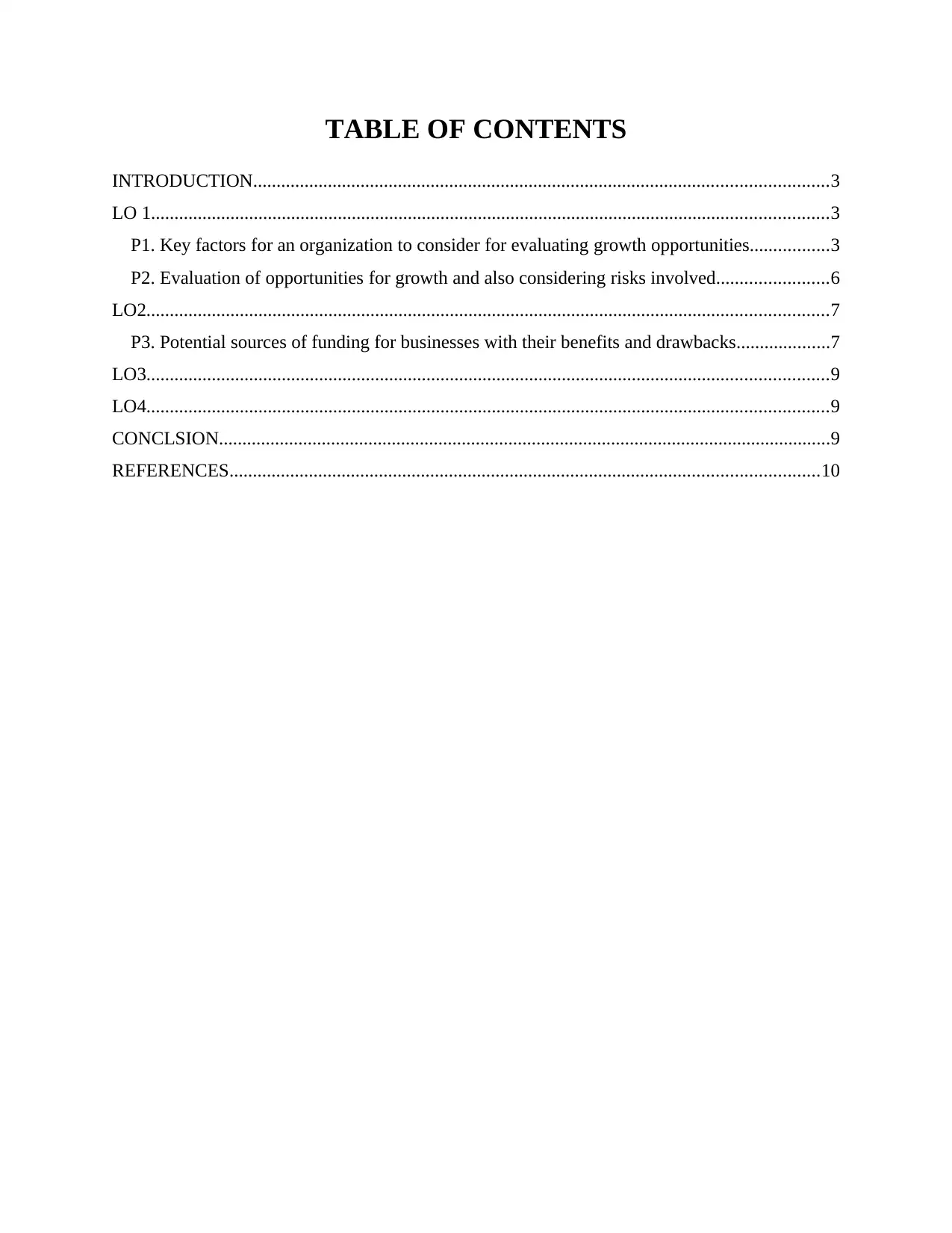
TABLE OF CONTENTS
INTRODUCTION...........................................................................................................................3
LO 1.................................................................................................................................................3
P1. Key factors for an organization to consider for evaluating growth opportunities.................3
P2. Evaluation of opportunities for growth and also considering risks involved........................6
LO2..................................................................................................................................................7
P3. Potential sources of funding for businesses with their benefits and drawbacks....................7
LO3..................................................................................................................................................9
LO4..................................................................................................................................................9
CONCLSION...................................................................................................................................9
REFERENCES..............................................................................................................................10
INTRODUCTION...........................................................................................................................3
LO 1.................................................................................................................................................3
P1. Key factors for an organization to consider for evaluating growth opportunities.................3
P2. Evaluation of opportunities for growth and also considering risks involved........................6
LO2..................................................................................................................................................7
P3. Potential sources of funding for businesses with their benefits and drawbacks....................7
LO3..................................................................................................................................................9
LO4..................................................................................................................................................9
CONCLSION...................................................................................................................................9
REFERENCES..............................................................................................................................10

INTRODUCTION
Planning for growth is the process or activity through which enterprises plan their
procedures in order to grow their organization. Also, it involves strategic analysis of factors
which an organization considers for their growth opportunities (Boulange, and et.al., 2018). This
report will be in context of Bonmarché. It was founded in 1982, and it is recognized as most
popular and successful budget fashion retailers across UK. This report analyses key
considerations for organization to evaluate growth opportunities while also justifying the same
through the use of Ansoff's growth vector matrix. This report assess options for growth for the
firm with the help of different frameworks and demonstrates the understanding of competitive
advantage for organization, while also considering risks involved (Bongaarts, 2016). The report
further provides potential sources of funding available for the organization with their benefits
and drawbacks, and assist in considering and adopting best option. The report also assesses an
appropriate business plan for the firm through financial informations and strategic objectives.
Then report further assess exit or succession options with their benefits and drawbacks for the
organization, with justifications supporting them.
LO 1
P1. Key factors for an organization to consider for evaluating growth opportunities
Organization should consider various factors for growth opportunities. This includes
considering various factors that help in gaining competitive advantage by innovating products
and services to expand its market share and profitability.
Competitive advantage: It is a condition or position through which an organization finds
themselves superior to others competitors in the market. Bonmarché should also allocate and use
differentiate technology to get competitive advantage. Company by using its capabilities offer
high quality services and products to its customers (Nainaar and Masson, 2018). Company can
also change its marketing strategies for attracting new customers as well as existing customers
which will help in gaining competitive advantageous in the industry.
Porter's generic strategies: The organization can also consider applying one of the
Porter's generic strategies for achieving competitive advantage, which includes:
Cost Leadership Strategy: Company can consider using this strategy, by reducing cost of
production and brining economic of scale thus offering product at reasonable prices that will
helps in enhancing profitability and gaining cost leadership advantageous.
Planning for growth is the process or activity through which enterprises plan their
procedures in order to grow their organization. Also, it involves strategic analysis of factors
which an organization considers for their growth opportunities (Boulange, and et.al., 2018). This
report will be in context of Bonmarché. It was founded in 1982, and it is recognized as most
popular and successful budget fashion retailers across UK. This report analyses key
considerations for organization to evaluate growth opportunities while also justifying the same
through the use of Ansoff's growth vector matrix. This report assess options for growth for the
firm with the help of different frameworks and demonstrates the understanding of competitive
advantage for organization, while also considering risks involved (Bongaarts, 2016). The report
further provides potential sources of funding available for the organization with their benefits
and drawbacks, and assist in considering and adopting best option. The report also assesses an
appropriate business plan for the firm through financial informations and strategic objectives.
Then report further assess exit or succession options with their benefits and drawbacks for the
organization, with justifications supporting them.
LO 1
P1. Key factors for an organization to consider for evaluating growth opportunities
Organization should consider various factors for growth opportunities. This includes
considering various factors that help in gaining competitive advantage by innovating products
and services to expand its market share and profitability.
Competitive advantage: It is a condition or position through which an organization finds
themselves superior to others competitors in the market. Bonmarché should also allocate and use
differentiate technology to get competitive advantage. Company by using its capabilities offer
high quality services and products to its customers (Nainaar and Masson, 2018). Company can
also change its marketing strategies for attracting new customers as well as existing customers
which will help in gaining competitive advantageous in the industry.
Porter's generic strategies: The organization can also consider applying one of the
Porter's generic strategies for achieving competitive advantage, which includes:
Cost Leadership Strategy: Company can consider using this strategy, by reducing cost of
production and brining economic of scale thus offering product at reasonable prices that will
helps in enhancing profitability and gaining cost leadership advantageous.
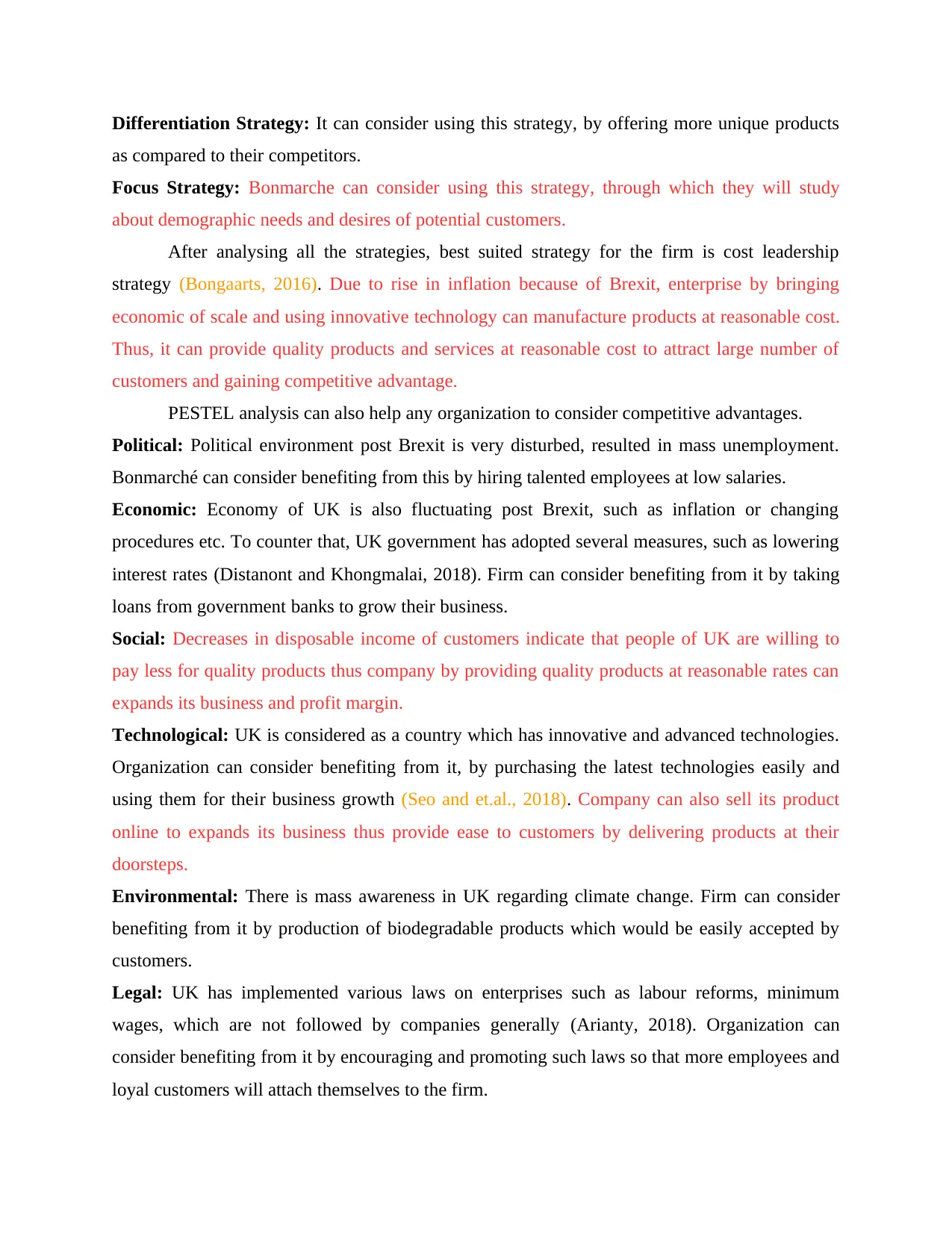
Differentiation Strategy: It can consider using this strategy, by offering more unique products
as compared to their competitors.
Focus Strategy: Bonmarche can consider using this strategy, through which they will study
about demographic needs and desires of potential customers.
After analysing all the strategies, best suited strategy for the firm is cost leadership
strategy (Bongaarts, 2016). Due to rise in inflation because of Brexit, enterprise by bringing
economic of scale and using innovative technology can manufacture products at reasonable cost.
Thus, it can provide quality products and services at reasonable cost to attract large number of
customers and gaining competitive advantage.
PESTEL analysis can also help any organization to consider competitive advantages.
Political: Political environment post Brexit is very disturbed, resulted in mass unemployment.
Bonmarché can consider benefiting from this by hiring talented employees at low salaries.
Economic: Economy of UK is also fluctuating post Brexit, such as inflation or changing
procedures etc. To counter that, UK government has adopted several measures, such as lowering
interest rates (Distanont and Khongmalai, 2018). Firm can consider benefiting from it by taking
loans from government banks to grow their business.
Social: Decreases in disposable income of customers indicate that people of UK are willing to
pay less for quality products thus company by providing quality products at reasonable rates can
expands its business and profit margin.
Technological: UK is considered as a country which has innovative and advanced technologies.
Organization can consider benefiting from it, by purchasing the latest technologies easily and
using them for their business growth (Seo and et.al., 2018). Company can also sell its product
online to expands its business thus provide ease to customers by delivering products at their
doorsteps.
Environmental: There is mass awareness in UK regarding climate change. Firm can consider
benefiting from it by production of biodegradable products which would be easily accepted by
customers.
Legal: UK has implemented various laws on enterprises such as labour reforms, minimum
wages, which are not followed by companies generally (Arianty, 2018). Organization can
consider benefiting from it by encouraging and promoting such laws so that more employees and
loyal customers will attach themselves to the firm.
as compared to their competitors.
Focus Strategy: Bonmarche can consider using this strategy, through which they will study
about demographic needs and desires of potential customers.
After analysing all the strategies, best suited strategy for the firm is cost leadership
strategy (Bongaarts, 2016). Due to rise in inflation because of Brexit, enterprise by bringing
economic of scale and using innovative technology can manufacture products at reasonable cost.
Thus, it can provide quality products and services at reasonable cost to attract large number of
customers and gaining competitive advantage.
PESTEL analysis can also help any organization to consider competitive advantages.
Political: Political environment post Brexit is very disturbed, resulted in mass unemployment.
Bonmarché can consider benefiting from this by hiring talented employees at low salaries.
Economic: Economy of UK is also fluctuating post Brexit, such as inflation or changing
procedures etc. To counter that, UK government has adopted several measures, such as lowering
interest rates (Distanont and Khongmalai, 2018). Firm can consider benefiting from it by taking
loans from government banks to grow their business.
Social: Decreases in disposable income of customers indicate that people of UK are willing to
pay less for quality products thus company by providing quality products at reasonable rates can
expands its business and profit margin.
Technological: UK is considered as a country which has innovative and advanced technologies.
Organization can consider benefiting from it, by purchasing the latest technologies easily and
using them for their business growth (Seo and et.al., 2018). Company can also sell its product
online to expands its business thus provide ease to customers by delivering products at their
doorsteps.
Environmental: There is mass awareness in UK regarding climate change. Firm can consider
benefiting from it by production of biodegradable products which would be easily accepted by
customers.
Legal: UK has implemented various laws on enterprises such as labour reforms, minimum
wages, which are not followed by companies generally (Arianty, 2018). Organization can
consider benefiting from it by encouraging and promoting such laws so that more employees and
loyal customers will attach themselves to the firm.
Secure Best Marks with AI Grader
Need help grading? Try our AI Grader for instant feedback on your assignments.
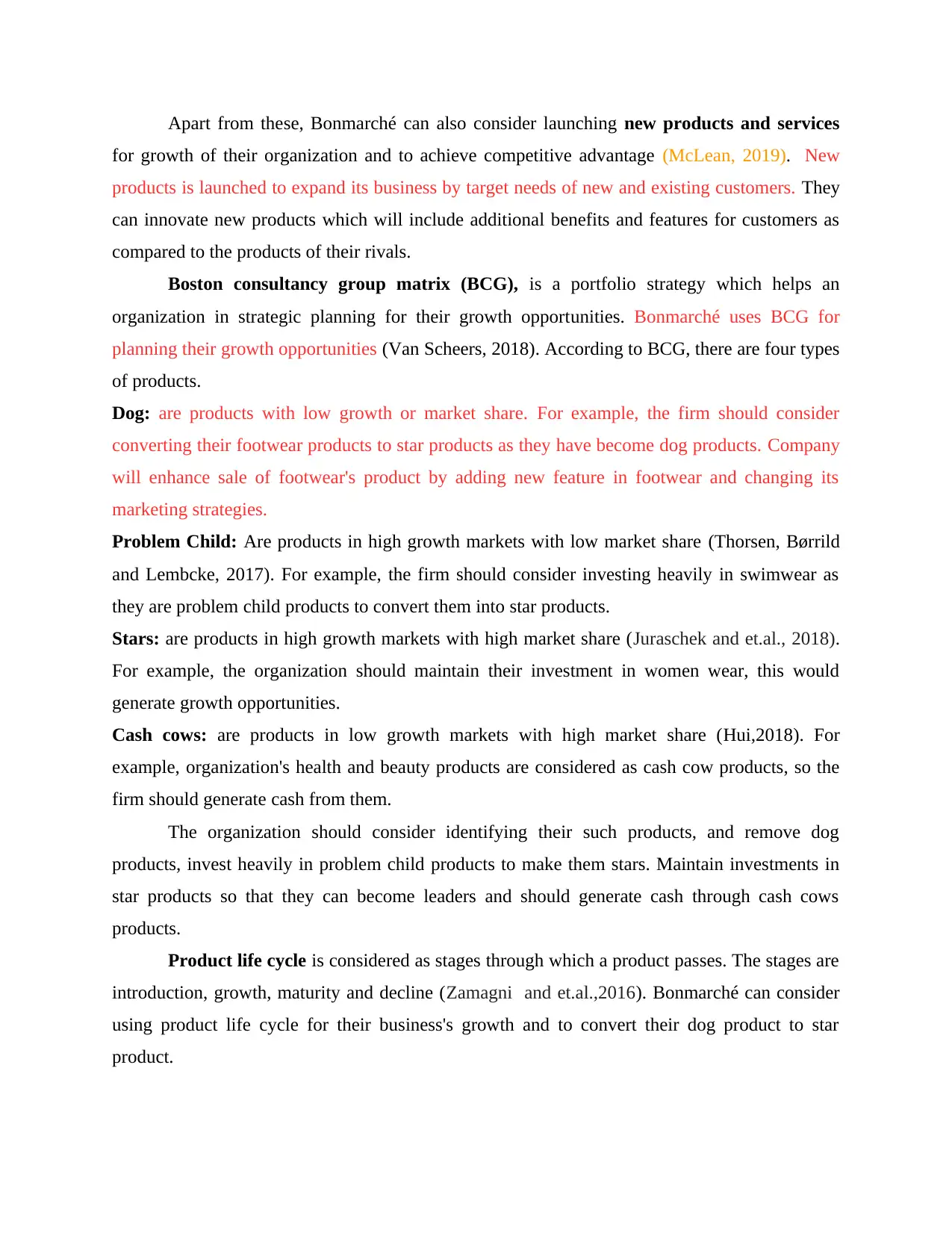
Apart from these, Bonmarché can also consider launching new products and services
for growth of their organization and to achieve competitive advantage (McLean, 2019). New
products is launched to expand its business by target needs of new and existing customers. They
can innovate new products which will include additional benefits and features for customers as
compared to the products of their rivals.
Boston consultancy group matrix (BCG), is a portfolio strategy which helps an
organization in strategic planning for their growth opportunities. Bonmarché uses BCG for
planning their growth opportunities (Van Scheers, 2018). According to BCG, there are four types
of products.
Dog: are products with low growth or market share. For example, the firm should consider
converting their footwear products to star products as they have become dog products. Company
will enhance sale of footwear's product by adding new feature in footwear and changing its
marketing strategies.
Problem Child: Are products in high growth markets with low market share (Thorsen, Børrild
and Lembcke, 2017). For example, the firm should consider investing heavily in swimwear as
they are problem child products to convert them into star products.
Stars: are products in high growth markets with high market share (Juraschek and et.al., 2018).
For example, the organization should maintain their investment in women wear, this would
generate growth opportunities.
Cash cows: are products in low growth markets with high market share (Hui,2018). For
example, organization's health and beauty products are considered as cash cow products, so the
firm should generate cash from them.
The organization should consider identifying their such products, and remove dog
products, invest heavily in problem child products to make them stars. Maintain investments in
star products so that they can become leaders and should generate cash through cash cows
products.
Product life cycle is considered as stages through which a product passes. The stages are
introduction, growth, maturity and decline (Zamagni and et.al.,2016). Bonmarché can consider
using product life cycle for their business's growth and to convert their dog product to star
product.
for growth of their organization and to achieve competitive advantage (McLean, 2019). New
products is launched to expand its business by target needs of new and existing customers. They
can innovate new products which will include additional benefits and features for customers as
compared to the products of their rivals.
Boston consultancy group matrix (BCG), is a portfolio strategy which helps an
organization in strategic planning for their growth opportunities. Bonmarché uses BCG for
planning their growth opportunities (Van Scheers, 2018). According to BCG, there are four types
of products.
Dog: are products with low growth or market share. For example, the firm should consider
converting their footwear products to star products as they have become dog products. Company
will enhance sale of footwear's product by adding new feature in footwear and changing its
marketing strategies.
Problem Child: Are products in high growth markets with low market share (Thorsen, Børrild
and Lembcke, 2017). For example, the firm should consider investing heavily in swimwear as
they are problem child products to convert them into star products.
Stars: are products in high growth markets with high market share (Juraschek and et.al., 2018).
For example, the organization should maintain their investment in women wear, this would
generate growth opportunities.
Cash cows: are products in low growth markets with high market share (Hui,2018). For
example, organization's health and beauty products are considered as cash cow products, so the
firm should generate cash from them.
The organization should consider identifying their such products, and remove dog
products, invest heavily in problem child products to make them stars. Maintain investments in
star products so that they can become leaders and should generate cash through cash cows
products.
Product life cycle is considered as stages through which a product passes. The stages are
introduction, growth, maturity and decline (Zamagni and et.al.,2016). Bonmarché can consider
using product life cycle for their business's growth and to convert their dog product to star
product.
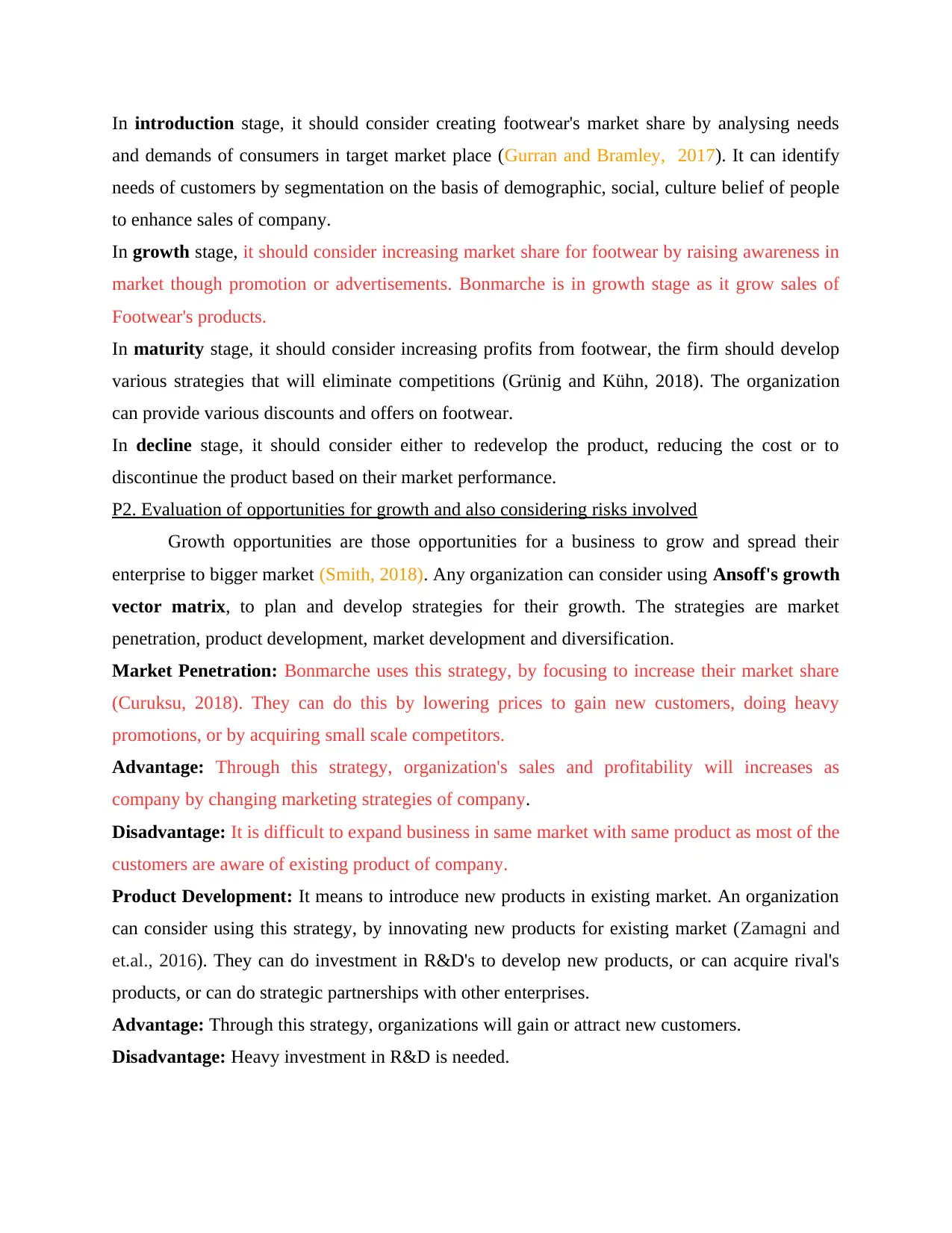
In introduction stage, it should consider creating footwear's market share by analysing needs
and demands of consumers in target market place (Gurran and Bramley, 2017). It can identify
needs of customers by segmentation on the basis of demographic, social, culture belief of people
to enhance sales of company.
In growth stage, it should consider increasing market share for footwear by raising awareness in
market though promotion or advertisements. Bonmarche is in growth stage as it grow sales of
Footwear's products.
In maturity stage, it should consider increasing profits from footwear, the firm should develop
various strategies that will eliminate competitions (Grünig and Kühn, 2018). The organization
can provide various discounts and offers on footwear.
In decline stage, it should consider either to redevelop the product, reducing the cost or to
discontinue the product based on their market performance.
P2. Evaluation of opportunities for growth and also considering risks involved
Growth opportunities are those opportunities for a business to grow and spread their
enterprise to bigger market (Smith, 2018). Any organization can consider using Ansoff's growth
vector matrix, to plan and develop strategies for their growth. The strategies are market
penetration, product development, market development and diversification.
Market Penetration: Bonmarche uses this strategy, by focusing to increase their market share
(Curuksu, 2018). They can do this by lowering prices to gain new customers, doing heavy
promotions, or by acquiring small scale competitors.
Advantage: Through this strategy, organization's sales and profitability will increases as
company by changing marketing strategies of company.
Disadvantage: It is difficult to expand business in same market with same product as most of the
customers are aware of existing product of company.
Product Development: It means to introduce new products in existing market. An organization
can consider using this strategy, by innovating new products for existing market (Zamagni and
et.al., 2016). They can do investment in R&D's to develop new products, or can acquire rival's
products, or can do strategic partnerships with other enterprises.
Advantage: Through this strategy, organizations will gain or attract new customers.
Disadvantage: Heavy investment in R&D is needed.
and demands of consumers in target market place (Gurran and Bramley, 2017). It can identify
needs of customers by segmentation on the basis of demographic, social, culture belief of people
to enhance sales of company.
In growth stage, it should consider increasing market share for footwear by raising awareness in
market though promotion or advertisements. Bonmarche is in growth stage as it grow sales of
Footwear's products.
In maturity stage, it should consider increasing profits from footwear, the firm should develop
various strategies that will eliminate competitions (Grünig and Kühn, 2018). The organization
can provide various discounts and offers on footwear.
In decline stage, it should consider either to redevelop the product, reducing the cost or to
discontinue the product based on their market performance.
P2. Evaluation of opportunities for growth and also considering risks involved
Growth opportunities are those opportunities for a business to grow and spread their
enterprise to bigger market (Smith, 2018). Any organization can consider using Ansoff's growth
vector matrix, to plan and develop strategies for their growth. The strategies are market
penetration, product development, market development and diversification.
Market Penetration: Bonmarche uses this strategy, by focusing to increase their market share
(Curuksu, 2018). They can do this by lowering prices to gain new customers, doing heavy
promotions, or by acquiring small scale competitors.
Advantage: Through this strategy, organization's sales and profitability will increases as
company by changing marketing strategies of company.
Disadvantage: It is difficult to expand business in same market with same product as most of the
customers are aware of existing product of company.
Product Development: It means to introduce new products in existing market. An organization
can consider using this strategy, by innovating new products for existing market (Zamagni and
et.al., 2016). They can do investment in R&D's to develop new products, or can acquire rival's
products, or can do strategic partnerships with other enterprises.
Advantage: Through this strategy, organizations will gain or attract new customers.
Disadvantage: Heavy investment in R&D is needed.
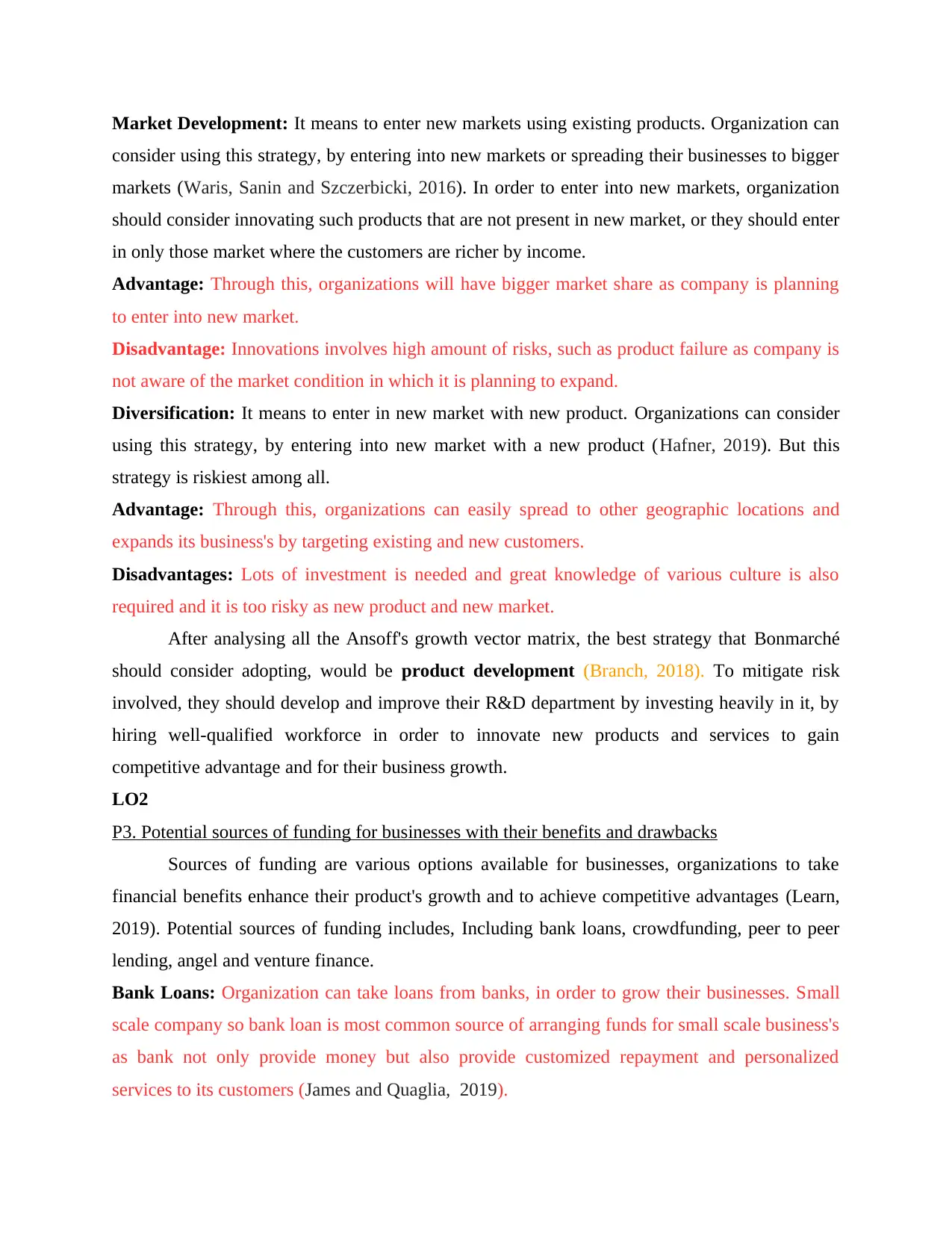
Market Development: It means to enter new markets using existing products. Organization can
consider using this strategy, by entering into new markets or spreading their businesses to bigger
markets (Waris, Sanin and Szczerbicki, 2016). In order to enter into new markets, organization
should consider innovating such products that are not present in new market, or they should enter
in only those market where the customers are richer by income.
Advantage: Through this, organizations will have bigger market share as company is planning
to enter into new market.
Disadvantage: Innovations involves high amount of risks, such as product failure as company is
not aware of the market condition in which it is planning to expand.
Diversification: It means to enter in new market with new product. Organizations can consider
using this strategy, by entering into new market with a new product (Hafner, 2019). But this
strategy is riskiest among all.
Advantage: Through this, organizations can easily spread to other geographic locations and
expands its business's by targeting existing and new customers.
Disadvantages: Lots of investment is needed and great knowledge of various culture is also
required and it is too risky as new product and new market.
After analysing all the Ansoff's growth vector matrix, the best strategy that Bonmarché
should consider adopting, would be product development (Branch, 2018). To mitigate risk
involved, they should develop and improve their R&D department by investing heavily in it, by
hiring well-qualified workforce in order to innovate new products and services to gain
competitive advantage and for their business growth.
LO2
P3. Potential sources of funding for businesses with their benefits and drawbacks
Sources of funding are various options available for businesses, organizations to take
financial benefits enhance their product's growth and to achieve competitive advantages (Learn,
2019). Potential sources of funding includes, Including bank loans, crowdfunding, peer to peer
lending, angel and venture finance.
Bank Loans: Organization can take loans from banks, in order to grow their businesses. Small
scale company so bank loan is most common source of arranging funds for small scale business's
as bank not only provide money but also provide customized repayment and personalized
services to its customers (James and Quaglia, 2019).
consider using this strategy, by entering into new markets or spreading their businesses to bigger
markets (Waris, Sanin and Szczerbicki, 2016). In order to enter into new markets, organization
should consider innovating such products that are not present in new market, or they should enter
in only those market where the customers are richer by income.
Advantage: Through this, organizations will have bigger market share as company is planning
to enter into new market.
Disadvantage: Innovations involves high amount of risks, such as product failure as company is
not aware of the market condition in which it is planning to expand.
Diversification: It means to enter in new market with new product. Organizations can consider
using this strategy, by entering into new market with a new product (Hafner, 2019). But this
strategy is riskiest among all.
Advantage: Through this, organizations can easily spread to other geographic locations and
expands its business's by targeting existing and new customers.
Disadvantages: Lots of investment is needed and great knowledge of various culture is also
required and it is too risky as new product and new market.
After analysing all the Ansoff's growth vector matrix, the best strategy that Bonmarché
should consider adopting, would be product development (Branch, 2018). To mitigate risk
involved, they should develop and improve their R&D department by investing heavily in it, by
hiring well-qualified workforce in order to innovate new products and services to gain
competitive advantage and for their business growth.
LO2
P3. Potential sources of funding for businesses with their benefits and drawbacks
Sources of funding are various options available for businesses, organizations to take
financial benefits enhance their product's growth and to achieve competitive advantages (Learn,
2019). Potential sources of funding includes, Including bank loans, crowdfunding, peer to peer
lending, angel and venture finance.
Bank Loans: Organization can take loans from banks, in order to grow their businesses. Small
scale company so bank loan is most common source of arranging funds for small scale business's
as bank not only provide money but also provide customized repayment and personalized
services to its customers (James and Quaglia, 2019).
Paraphrase This Document
Need a fresh take? Get an instant paraphrase of this document with our AI Paraphraser
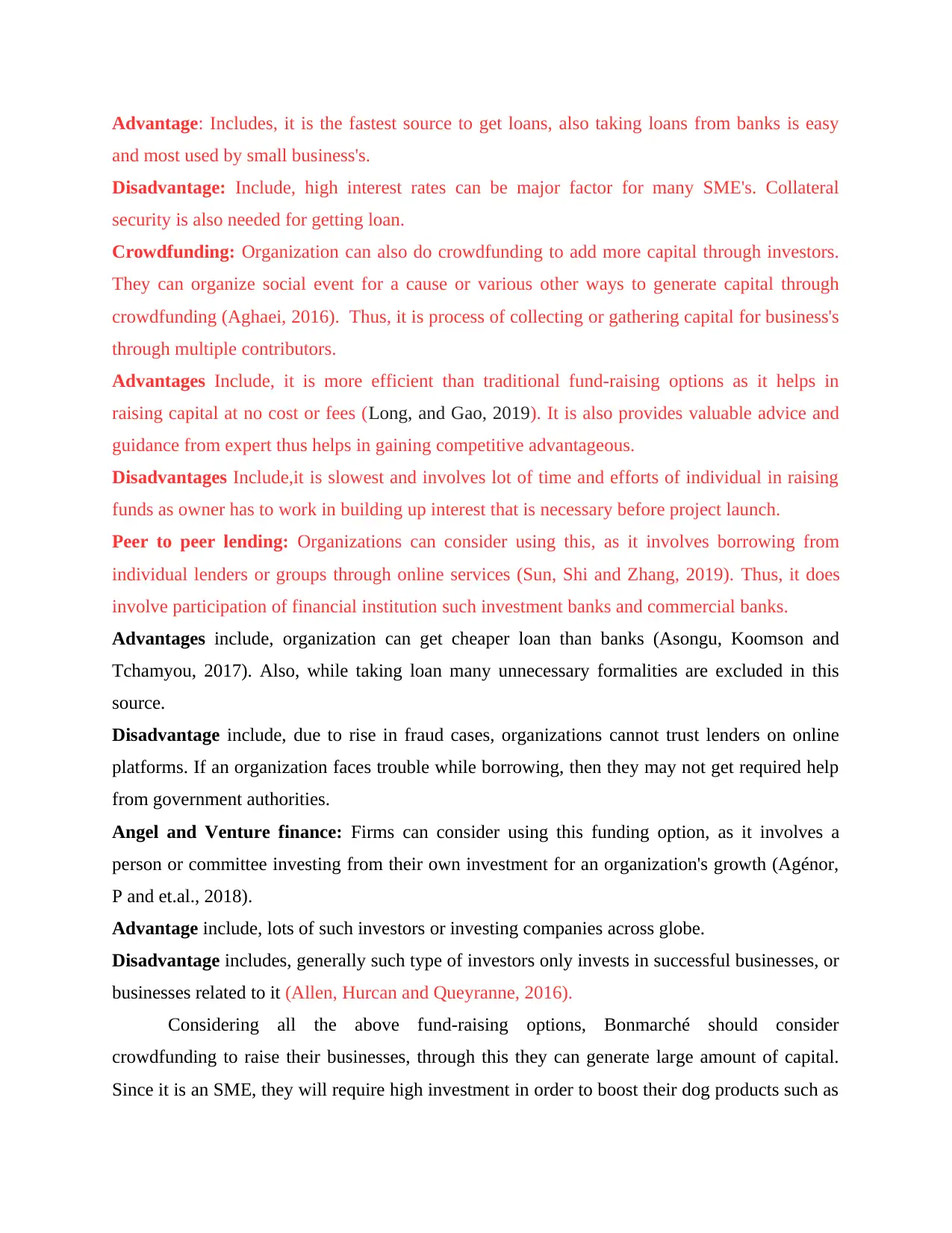
Advantage: Includes, it is the fastest source to get loans, also taking loans from banks is easy
and most used by small business's.
Disadvantage: Include, high interest rates can be major factor for many SME's. Collateral
security is also needed for getting loan.
Crowdfunding: Organization can also do crowdfunding to add more capital through investors.
They can organize social event for a cause or various other ways to generate capital through
crowdfunding (Aghaei, 2016). Thus, it is process of collecting or gathering capital for business's
through multiple contributors.
Advantages Include, it is more efficient than traditional fund-raising options as it helps in
raising capital at no cost or fees (Long, and Gao, 2019). It is also provides valuable advice and
guidance from expert thus helps in gaining competitive advantageous.
Disadvantages Include,it is slowest and involves lot of time and efforts of individual in raising
funds as owner has to work in building up interest that is necessary before project launch.
Peer to peer lending: Organizations can consider using this, as it involves borrowing from
individual lenders or groups through online services (Sun, Shi and Zhang, 2019). Thus, it does
involve participation of financial institution such investment banks and commercial banks.
Advantages include, organization can get cheaper loan than banks (Asongu, Koomson and
Tchamyou, 2017). Also, while taking loan many unnecessary formalities are excluded in this
source.
Disadvantage include, due to rise in fraud cases, organizations cannot trust lenders on online
platforms. If an organization faces trouble while borrowing, then they may not get required help
from government authorities.
Angel and Venture finance: Firms can consider using this funding option, as it involves a
person or committee investing from their own investment for an organization's growth (Agénor,
P and et.al., 2018).
Advantage include, lots of such investors or investing companies across globe.
Disadvantage includes, generally such type of investors only invests in successful businesses, or
businesses related to it (Allen, Hurcan and Queyranne, 2016).
Considering all the above fund-raising options, Bonmarché should consider
crowdfunding to raise their businesses, through this they can generate large amount of capital.
Since it is an SME, they will require high investment in order to boost their dog products such as
and most used by small business's.
Disadvantage: Include, high interest rates can be major factor for many SME's. Collateral
security is also needed for getting loan.
Crowdfunding: Organization can also do crowdfunding to add more capital through investors.
They can organize social event for a cause or various other ways to generate capital through
crowdfunding (Aghaei, 2016). Thus, it is process of collecting or gathering capital for business's
through multiple contributors.
Advantages Include, it is more efficient than traditional fund-raising options as it helps in
raising capital at no cost or fees (Long, and Gao, 2019). It is also provides valuable advice and
guidance from expert thus helps in gaining competitive advantageous.
Disadvantages Include,it is slowest and involves lot of time and efforts of individual in raising
funds as owner has to work in building up interest that is necessary before project launch.
Peer to peer lending: Organizations can consider using this, as it involves borrowing from
individual lenders or groups through online services (Sun, Shi and Zhang, 2019). Thus, it does
involve participation of financial institution such investment banks and commercial banks.
Advantages include, organization can get cheaper loan than banks (Asongu, Koomson and
Tchamyou, 2017). Also, while taking loan many unnecessary formalities are excluded in this
source.
Disadvantage include, due to rise in fraud cases, organizations cannot trust lenders on online
platforms. If an organization faces trouble while borrowing, then they may not get required help
from government authorities.
Angel and Venture finance: Firms can consider using this funding option, as it involves a
person or committee investing from their own investment for an organization's growth (Agénor,
P and et.al., 2018).
Advantage include, lots of such investors or investing companies across globe.
Disadvantage includes, generally such type of investors only invests in successful businesses, or
businesses related to it (Allen, Hurcan and Queyranne, 2016).
Considering all the above fund-raising options, Bonmarché should consider
crowdfunding to raise their businesses, through this they can generate large amount of capital.
Since it is an SME, they will require high investment in order to boost their dog products such as
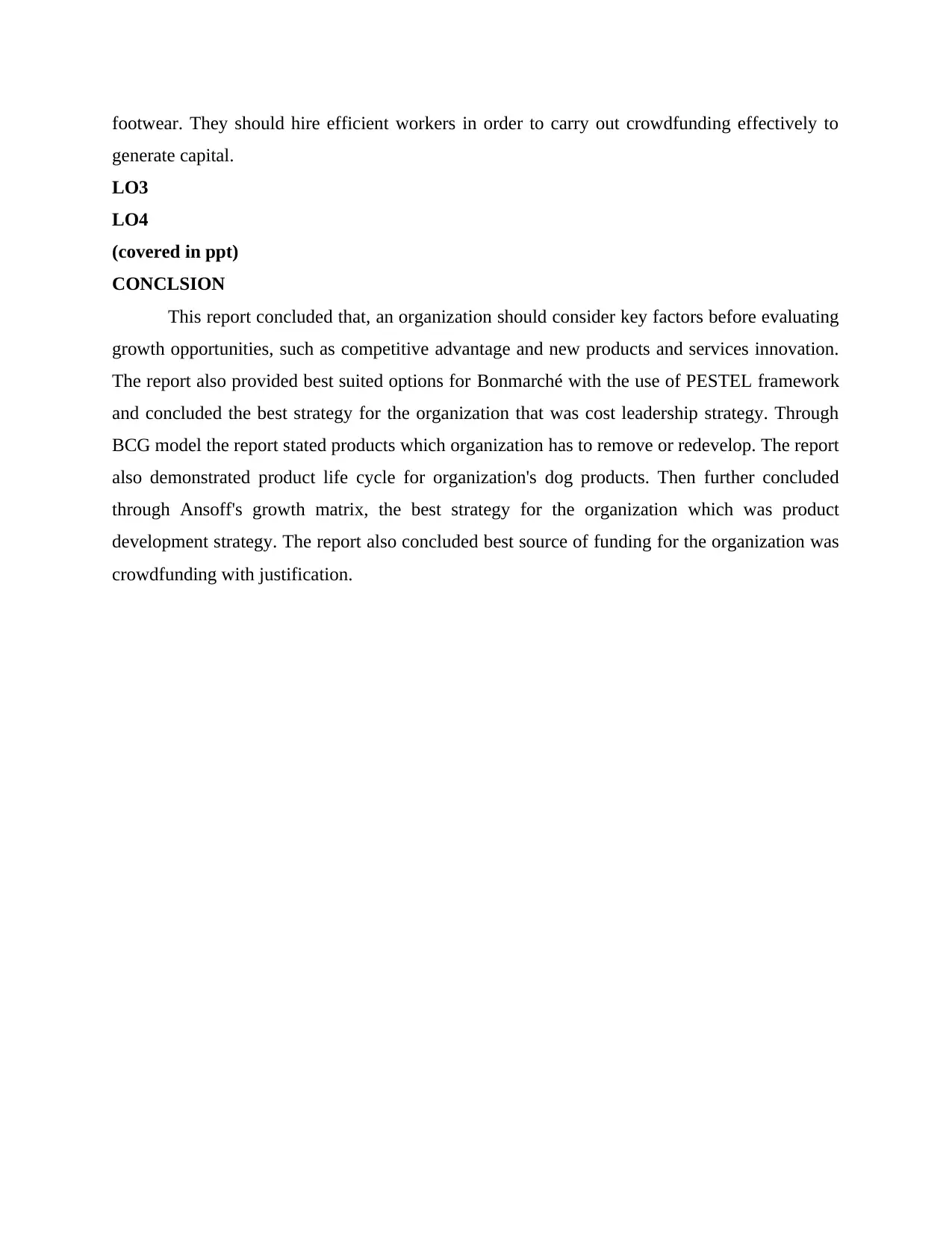
footwear. They should hire efficient workers in order to carry out crowdfunding effectively to
generate capital.
LO3
LO4
(covered in ppt)
CONCLSION
This report concluded that, an organization should consider key factors before evaluating
growth opportunities, such as competitive advantage and new products and services innovation.
The report also provided best suited options for Bonmarché with the use of PESTEL framework
and concluded the best strategy for the organization that was cost leadership strategy. Through
BCG model the report stated products which organization has to remove or redevelop. The report
also demonstrated product life cycle for organization's dog products. Then further concluded
through Ansoff's growth matrix, the best strategy for the organization which was product
development strategy. The report also concluded best source of funding for the organization was
crowdfunding with justification.
generate capital.
LO3
LO4
(covered in ppt)
CONCLSION
This report concluded that, an organization should consider key factors before evaluating
growth opportunities, such as competitive advantage and new products and services innovation.
The report also provided best suited options for Bonmarché with the use of PESTEL framework
and concluded the best strategy for the organization that was cost leadership strategy. Through
BCG model the report stated products which organization has to remove or redevelop. The report
also demonstrated product life cycle for organization's dog products. Then further concluded
through Ansoff's growth matrix, the best strategy for the organization which was product
development strategy. The report also concluded best source of funding for the organization was
crowdfunding with justification.
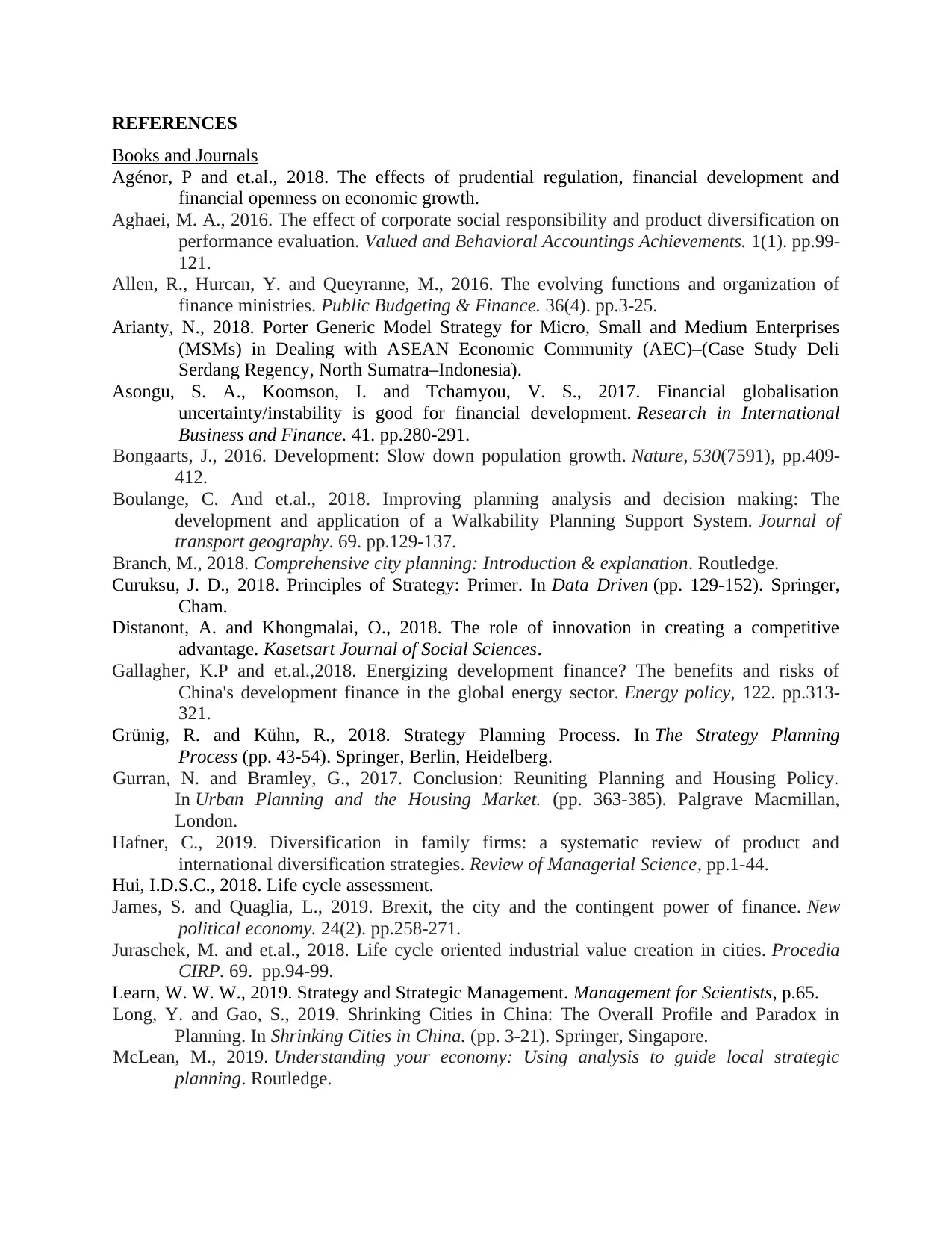
REFERENCES
Books and Journals
Agénor, P and et.al., 2018. The effects of prudential regulation, financial development and
financial openness on economic growth.
Aghaei, M. A., 2016. The effect of corporate social responsibility and product diversification on
performance evaluation. Valued and Behavioral Accountings Achievements. 1(1). pp.99-
121.
Allen, R., Hurcan, Y. and Queyranne, M., 2016. The evolving functions and organization of
finance ministries. Public Budgeting & Finance. 36(4). pp.3-25.
Arianty, N., 2018. Porter Generic Model Strategy for Micro, Small and Medium Enterprises
(MSMs) in Dealing with ASEAN Economic Community (AEC)–(Case Study Deli
Serdang Regency, North Sumatra–Indonesia).
Asongu, S. A., Koomson, I. and Tchamyou, V. S., 2017. Financial globalisation
uncertainty/instability is good for financial development. Research in International
Business and Finance. 41. pp.280-291.
Bongaarts, J., 2016. Development: Slow down population growth. Nature, 530(7591), pp.409-
412.
Boulange, C. And et.al., 2018. Improving planning analysis and decision making: The
development and application of a Walkability Planning Support System. Journal of
transport geography. 69. pp.129-137.
Branch, M., 2018. Comprehensive city planning: Introduction & explanation. Routledge.
Curuksu, J. D., 2018. Principles of Strategy: Primer. In Data Driven (pp. 129-152). Springer,
Cham.
Distanont, A. and Khongmalai, O., 2018. The role of innovation in creating a competitive
advantage. Kasetsart Journal of Social Sciences.
Gallagher, K.P and et.al.,2018. Energizing development finance? The benefits and risks of
China's development finance in the global energy sector. Energy policy, 122. pp.313-
321.
Grünig, R. and Kühn, R., 2018. Strategy Planning Process. In The Strategy Planning
Process (pp. 43-54). Springer, Berlin, Heidelberg.
Gurran, N. and Bramley, G., 2017. Conclusion: Reuniting Planning and Housing Policy.
In Urban Planning and the Housing Market. (pp. 363-385). Palgrave Macmillan,
London.
Hafner, C., 2019. Diversification in family firms: a systematic review of product and
international diversification strategies. Review of Managerial Science, pp.1-44.
Hui, I.D.S.C., 2018. Life cycle assessment.
James, S. and Quaglia, L., 2019. Brexit, the city and the contingent power of finance. New
political economy. 24(2). pp.258-271.
Juraschek, M. and et.al., 2018. Life cycle oriented industrial value creation in cities. Procedia
CIRP. 69. pp.94-99.
Learn, W. W. W., 2019. Strategy and Strategic Management. Management for Scientists, p.65.
Long, Y. and Gao, S., 2019. Shrinking Cities in China: The Overall Profile and Paradox in
Planning. In Shrinking Cities in China. (pp. 3-21). Springer, Singapore.
McLean, M., 2019. Understanding your economy: Using analysis to guide local strategic
planning. Routledge.
Books and Journals
Agénor, P and et.al., 2018. The effects of prudential regulation, financial development and
financial openness on economic growth.
Aghaei, M. A., 2016. The effect of corporate social responsibility and product diversification on
performance evaluation. Valued and Behavioral Accountings Achievements. 1(1). pp.99-
121.
Allen, R., Hurcan, Y. and Queyranne, M., 2016. The evolving functions and organization of
finance ministries. Public Budgeting & Finance. 36(4). pp.3-25.
Arianty, N., 2018. Porter Generic Model Strategy for Micro, Small and Medium Enterprises
(MSMs) in Dealing with ASEAN Economic Community (AEC)–(Case Study Deli
Serdang Regency, North Sumatra–Indonesia).
Asongu, S. A., Koomson, I. and Tchamyou, V. S., 2017. Financial globalisation
uncertainty/instability is good for financial development. Research in International
Business and Finance. 41. pp.280-291.
Bongaarts, J., 2016. Development: Slow down population growth. Nature, 530(7591), pp.409-
412.
Boulange, C. And et.al., 2018. Improving planning analysis and decision making: The
development and application of a Walkability Planning Support System. Journal of
transport geography. 69. pp.129-137.
Branch, M., 2018. Comprehensive city planning: Introduction & explanation. Routledge.
Curuksu, J. D., 2018. Principles of Strategy: Primer. In Data Driven (pp. 129-152). Springer,
Cham.
Distanont, A. and Khongmalai, O., 2018. The role of innovation in creating a competitive
advantage. Kasetsart Journal of Social Sciences.
Gallagher, K.P and et.al.,2018. Energizing development finance? The benefits and risks of
China's development finance in the global energy sector. Energy policy, 122. pp.313-
321.
Grünig, R. and Kühn, R., 2018. Strategy Planning Process. In The Strategy Planning
Process (pp. 43-54). Springer, Berlin, Heidelberg.
Gurran, N. and Bramley, G., 2017. Conclusion: Reuniting Planning and Housing Policy.
In Urban Planning and the Housing Market. (pp. 363-385). Palgrave Macmillan,
London.
Hafner, C., 2019. Diversification in family firms: a systematic review of product and
international diversification strategies. Review of Managerial Science, pp.1-44.
Hui, I.D.S.C., 2018. Life cycle assessment.
James, S. and Quaglia, L., 2019. Brexit, the city and the contingent power of finance. New
political economy. 24(2). pp.258-271.
Juraschek, M. and et.al., 2018. Life cycle oriented industrial value creation in cities. Procedia
CIRP. 69. pp.94-99.
Learn, W. W. W., 2019. Strategy and Strategic Management. Management for Scientists, p.65.
Long, Y. and Gao, S., 2019. Shrinking Cities in China: The Overall Profile and Paradox in
Planning. In Shrinking Cities in China. (pp. 3-21). Springer, Singapore.
McLean, M., 2019. Understanding your economy: Using analysis to guide local strategic
planning. Routledge.
Secure Best Marks with AI Grader
Need help grading? Try our AI Grader for instant feedback on your assignments.
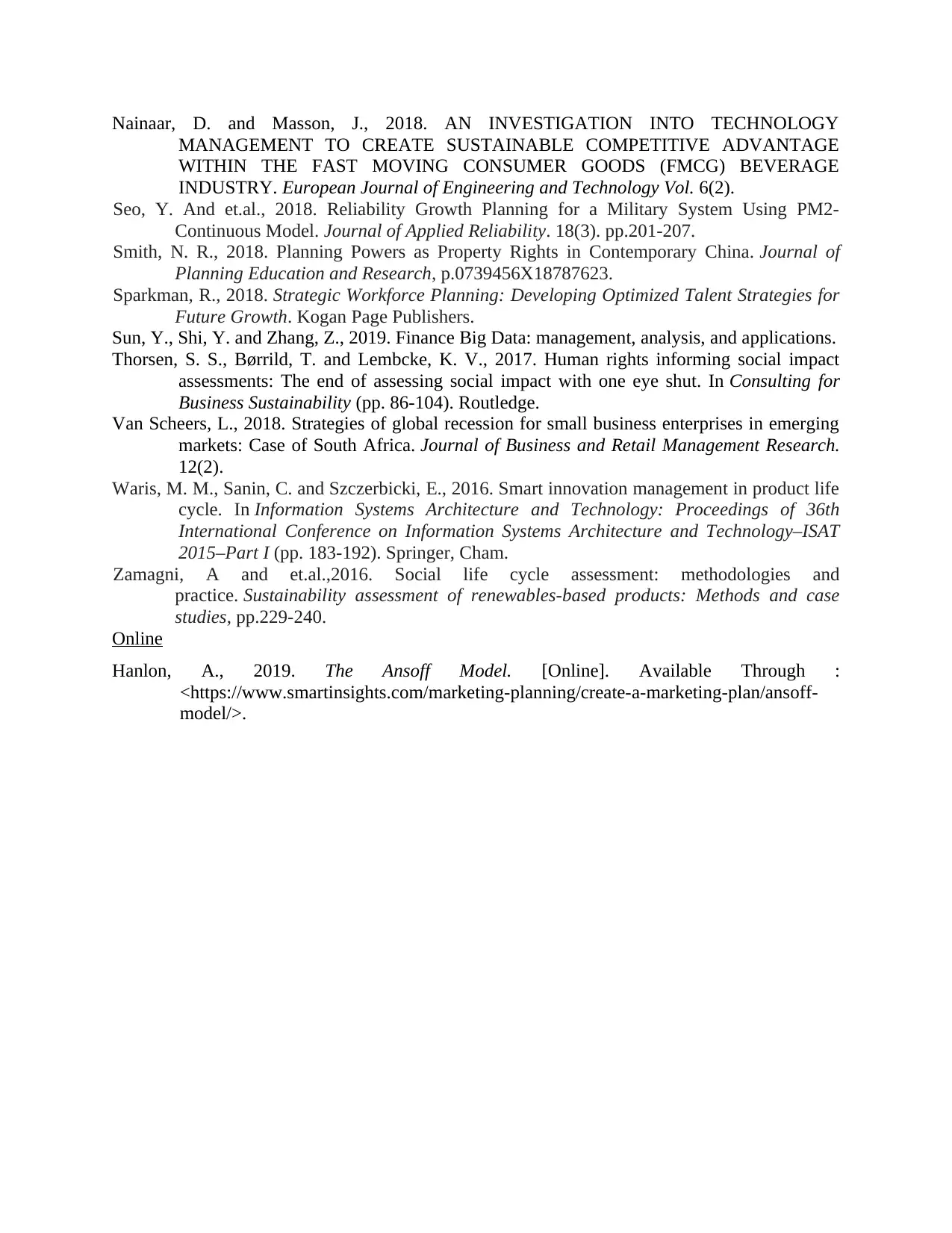
Nainaar, D. and Masson, J., 2018. AN INVESTIGATION INTO TECHNOLOGY
MANAGEMENT TO CREATE SUSTAINABLE COMPETITIVE ADVANTAGE
WITHIN THE FAST MOVING CONSUMER GOODS (FMCG) BEVERAGE
INDUSTRY. European Journal of Engineering and Technology Vol. 6(2).
Seo, Y. And et.al., 2018. Reliability Growth Planning for a Military System Using PM2-
Continuous Model. Journal of Applied Reliability. 18(3). pp.201-207.
Smith, N. R., 2018. Planning Powers as Property Rights in Contemporary China. Journal of
Planning Education and Research, p.0739456X18787623.
Sparkman, R., 2018. Strategic Workforce Planning: Developing Optimized Talent Strategies for
Future Growth. Kogan Page Publishers.
Sun, Y., Shi, Y. and Zhang, Z., 2019. Finance Big Data: management, analysis, and applications.
Thorsen, S. S., Børrild, T. and Lembcke, K. V., 2017. Human rights informing social impact
assessments: The end of assessing social impact with one eye shut. In Consulting for
Business Sustainability (pp. 86-104). Routledge.
Van Scheers, L., 2018. Strategies of global recession for small business enterprises in emerging
markets: Case of South Africa. Journal of Business and Retail Management Research.
12(2).
Waris, M. M., Sanin, C. and Szczerbicki, E., 2016. Smart innovation management in product life
cycle. In Information Systems Architecture and Technology: Proceedings of 36th
International Conference on Information Systems Architecture and Technology–ISAT
2015–Part I (pp. 183-192). Springer, Cham.
Zamagni, A and et.al.,2016. Social life cycle assessment: methodologies and
practice. Sustainability assessment of renewables-based products: Methods and case
studies, pp.229-240.
Online
Hanlon, A., 2019. The Ansoff Model. [Online]. Available Through :
<https://www.smartinsights.com/marketing-planning/create-a-marketing-plan/ansoff-
model/>.
MANAGEMENT TO CREATE SUSTAINABLE COMPETITIVE ADVANTAGE
WITHIN THE FAST MOVING CONSUMER GOODS (FMCG) BEVERAGE
INDUSTRY. European Journal of Engineering and Technology Vol. 6(2).
Seo, Y. And et.al., 2018. Reliability Growth Planning for a Military System Using PM2-
Continuous Model. Journal of Applied Reliability. 18(3). pp.201-207.
Smith, N. R., 2018. Planning Powers as Property Rights in Contemporary China. Journal of
Planning Education and Research, p.0739456X18787623.
Sparkman, R., 2018. Strategic Workforce Planning: Developing Optimized Talent Strategies for
Future Growth. Kogan Page Publishers.
Sun, Y., Shi, Y. and Zhang, Z., 2019. Finance Big Data: management, analysis, and applications.
Thorsen, S. S., Børrild, T. and Lembcke, K. V., 2017. Human rights informing social impact
assessments: The end of assessing social impact with one eye shut. In Consulting for
Business Sustainability (pp. 86-104). Routledge.
Van Scheers, L., 2018. Strategies of global recession for small business enterprises in emerging
markets: Case of South Africa. Journal of Business and Retail Management Research.
12(2).
Waris, M. M., Sanin, C. and Szczerbicki, E., 2016. Smart innovation management in product life
cycle. In Information Systems Architecture and Technology: Proceedings of 36th
International Conference on Information Systems Architecture and Technology–ISAT
2015–Part I (pp. 183-192). Springer, Cham.
Zamagni, A and et.al.,2016. Social life cycle assessment: methodologies and
practice. Sustainability assessment of renewables-based products: Methods and case
studies, pp.229-240.
Online
Hanlon, A., 2019. The Ansoff Model. [Online]. Available Through :
<https://www.smartinsights.com/marketing-planning/create-a-marketing-plan/ansoff-
model/>.
1 out of 11
Related Documents
Your All-in-One AI-Powered Toolkit for Academic Success.
+13062052269
info@desklib.com
Available 24*7 on WhatsApp / Email
![[object Object]](/_next/static/media/star-bottom.7253800d.svg)
Unlock your academic potential
© 2024 | Zucol Services PVT LTD | All rights reserved.



